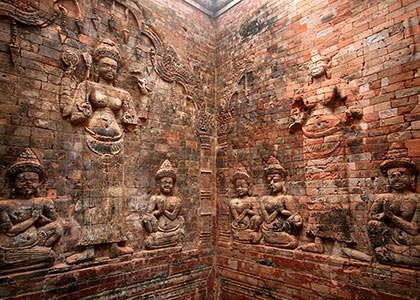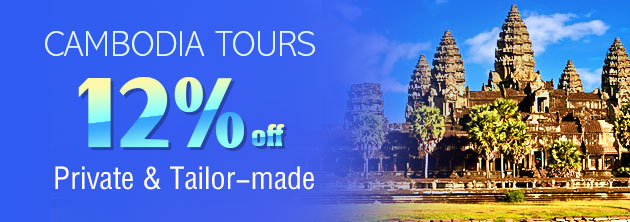Prasat Kravan Temple
The ancient city of Angkor may have been abandoned centuries ago, but its monuments and temples have left a lasting impression on the world; an impression so big, that thousands of travelers still travel to Cambodia to witness their brilliant architectural details. One of the temples that features prominently on the bucket list of any tourist visiting the Angkor Archaeological Park is the temple known as Prasat Kravan.Prasat Kravan is a temple that is located quite close to the main Angkor Wat temple. It may be significantly smaller in size, but its architectural features make it one of the best examples of ancient Khmer architecture at its finest. It is probably the only temple in Angkor that features brick carvings. The brick carving architectural style was originally seen in Vietnam’s Cham temples.
The History of Prasat Kravan

Reliefs of Prasat Kravan Temple
|
If you visit the temple, you may see several stones that feature inscriptions that read “CA”. These are the new stones that were added during the restoration efforts in the 1960s.
The Moat & Cruciform Terrace
Like most other Hindu temples, Prasat Kravan faces the east. A moat surrounds the temple and accessing the temple requires visitors to cross the moat via a causeway that is located in the temple grounds’ western section. A large cruciform terrace is present to the east of the temple’s towers. Archaeologists believe that an entrance may have possibly existed here previously. However, as it was probably made from perishable material, it no longer is a part of the temple complex.Prasat Kravan’s Sanctuaries
The stairway leading up to the sanctuaries housed within each tower features remnants of some lion statues. According to archaeologists, every single sanctuary was guarded by its very own lion statue during the glory days of the temple. The central sanctuary has four tiers, as many as it originally had. While the southern sanctuary only has two remaining tiers, the tiers of the other three sanctuaries have perished with time.Bas Reliefs of Lord Vishnu & Goddess Lakshmi
The significance of the Prasat Kravan Temple comes from the bas reliefs that can be witnessed in the central sanctuary, as the temple was built in dedication to Lord Vishnu, one of Hinduism’s most revered deities. The three bas reliefs feature depictions of Lord Vishnu from various cherished tales from Hindu mythology. They are:• An eight-armed Lord Vishnu standing in a statue-like position on a lizard or crocodile and surrounded by numerous tiny devotees. Archaeologists are yet to uncover the significance of this particular bas relief.
• A four-armed Lord Vishnu holding his baton, conch, discus, and globe, and taking a large step. This depicts Lord Vishnu in one of his avatars, that of the dwarf called Vamana when he took three large steps to overthrow the demon called Bali and reclaim the world from him.
• A four-armed Lord Vishnu sitting on his mount called Garuda and holding his baton, conch, discus, and globe.

Prasat Kravan Temple
|
Apart from the Vishnu bas reliefs, the temple is also home to bas reliefs of Lord Vishnu’s consort, the goddess Lakshmi, which can be found on the interior walls of the temple’s northernmost tower. In one of Lakshmi’s bas reliefs, she can be seen holding lotuses. In the other bas relief, she can be seen holding Vishnu’s discus and Lord Shiva’s trident. Archaeologists believe that the second bas relief portrays Lakshmi as a great Hindu goddess who has transcended the duality associated with the worship of Lord Shiva and Lord Vishnu.
Best Time to Visit Prasat Kravan
It may be difficult for you to travel within the country due to the high levels of heat and humidity during Cambodian summers. However, you can expect the country to be free from tourists as summers are considered off-season. While roads may get muddy and slushy with regular rainfall, monsoons too are considered off-season and don’t see many tourists in Prasat Kravan.Winters are the peak tourist season in Cambodia and if you plan to visit the temple during the winter months, then expect to see a lot of crowds.
All in all, the decision regarding when to visit Prasat Kravan depends on your financial situation and what kind of experience you are looking for. If your financial health is not faring too well and you prefer a peaceful vibe, then summers or monsoons may be the best time to visit the temple for you.
How to Reach Prasat Kravan?
Prasat Kravan is less than 12 km (7.5 miles) from the Siem Reap International Airport. Take the Angkor Wat road from Siem Reap. You can get to Angkor Wat by hiring:• Bicycles: Bicycle rentals are quite cheap in Siem Reap and would cost you in the range of USA$1-5 as daily rental charges.
• Tuk-tuks: Tuk-tuk tours of the famous Angkor temples can cost between USA$15-25 depending on the number of temples you want to visit.
• Taxis: Significantly pricier than tuk-tuks, taxi tours generally cost upwards of USA$25.
Once you reach Angkor Wat’s moat, take a right. Keep going straight and you will come across the Prasat Kravan temple on your right-hand side.
Entering Prasat Kravan requires you to buy the Angkor temple pass.
Entry Ticket Prices: $37 for one-day passes, $62 for three-day passes, and $72 for seven-day passesAngkor Archaeological Park Timings: 9:00 AM – 6:00 PM
Nearby Attractions:
Banteay Kdei Srah Srang Ta Prohm Temple

